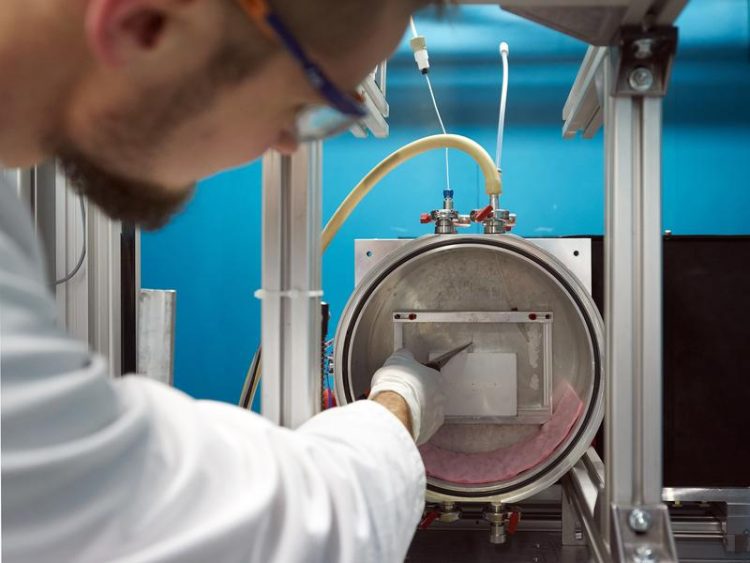Neutrons pave the way to accelerated production of lithium-ion cells

Mounting of a battery cell in the instrument ANTARES at FRM II. Photo: Wenzel Schürmann / TUM
One of the most critical and time-consuming processes in battery production is the filling of lithium cells with electrolyte fluid following the placement the of electrodes in a battery cell. While the actual filling process takes only a few seconds, battery manufacturers often wait several hours to ensure the liquid is fully absorbed into the pores of the electrode stack.
The fact that neutrons are hardly absorbed by the metal battery housing makes them ideal for analyzing batteries. That is why Bosch employees, in collaboration with scientists from the TU Munich and the University of Erlangen-Nuremberg, investigated the filling process at the neutron imaging and tomography facility ANTARES of the research neutron source FRM II.
Faster in a vacuum
Manufacturers of lithium cells often fill the empty cells in a vacuum. The process is monitored indirectly using resistance measurements. “To make sure that all the pores of the electrodes are filled with the electrolyte, manufacturers build in large safety margins,” says Bosch developer Dr. Wolfgang Weydanz. “That costs time and money.”
In the light of the neutrons, the scientists recognized that in a vacuum the electrodes were wetted completely in just over 50 minutes. Under normal pressure, this takes around 100 minutes. The liquid spreads evenly in the battery cell from all four sides, from the outside in.
In addition, the electrodes absorb ten percent less electrolyte under normal pressure. The culprit is gases that hinder the wetting process, as the scientists were able to demonstrate for the first time using the neutrons.
Publication:
Visualization of electrolyte filling process and influence of vacuum during filling for hard case prismatic lithium ion cells by neutron imaging to optimize the production process
W.J. Weydanz, H. Reisenweber, A. Gottschalk, M. Schulz, T. Knoche, G. Reinhart, M. Masuch, J. Franke, R. Gilles
Journal of Power Sources, Volume 380, 15 March 2018, Pages 126–134, https://doi.org/10.1016/j.jpowsour.2018.01.081
Link: https://www.sciencedirect.com/science/article/pii/S0378775318300818
Contact:
Dr. Ralph Gilles
Technical University Munich
Research-Neutronsource Heinz Maier-Leibnitz (FRM II)
Phone: +49 89 289 14665
Ralph.Gilles@frm2.tum.de
http://www.mlz-garching.de/antares
https://www.tum.de/nc/en/about-tum/news/press-releases/detail/article/34531/ Link to the press release
Link to the video: Elektrolyt-Befüllung von Lithiumionen-Akkus im Licht eines Neutronenstrahls
Media Contact
All latest news from the category: Power and Electrical Engineering
This topic covers issues related to energy generation, conversion, transportation and consumption and how the industry is addressing the challenge of energy efficiency in general.
innovations-report provides in-depth and informative reports and articles on subjects ranging from wind energy, fuel cell technology, solar energy, geothermal energy, petroleum, gas, nuclear engineering, alternative energy and energy efficiency to fusion, hydrogen and superconductor technologies.
Newest articles

NASA: Mystery of life’s handedness deepens
The mystery of why life uses molecules with specific orientations has deepened with a NASA-funded discovery that RNA — a key molecule thought to have potentially held the instructions for…

What are the effects of historic lithium mining on water quality?
Study reveals low levels of common contaminants but high levels of other elements in waters associated with an abandoned lithium mine. Lithium ore and mining waste from a historic lithium…

Quantum-inspired design boosts efficiency of heat-to-electricity conversion
Rice engineers take unconventional route to improving thermophotovoltaic systems. Researchers at Rice University have found a new way to improve a key element of thermophotovoltaic (TPV) systems, which convert heat…



